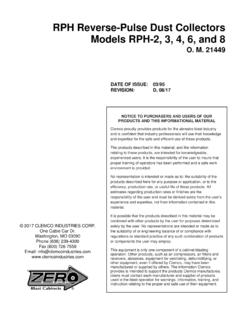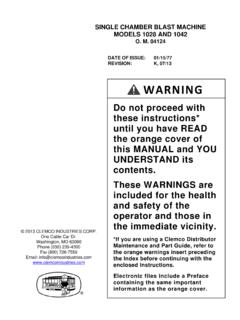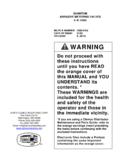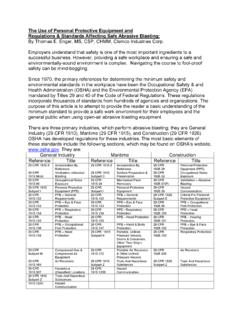Transcription of 24658DM CMS-3 CO Monitor Rev D - Clemco Industries
1 CMS-3 IN-HELMET CARBON MONOXIDE MONITORO. M. 24658 2015 Clemco Industries CORP. One Cable Car Dr. Washington, MO 63090 Phone (636) 239-4300 Fax (800) 726-7559 Email: DATE OF ISSUE: January 2011 REVISION: D, 04/15 Do not use this equipment until you have READ this MANUAL and YOU UNDERSTAND its contents. * These WARNINGS are included for the health and safety of the operator and those in the immediate vicinity. *If you are using a Clemco Distributor Maintenance and Parts Guide, refer to the orange warnings insert preceding the Index before continuing with the enclosed instructions. Electronic files include a Preface containing important information. WARNING CMS-3 IN-HELMET CARBON MONOXIDE Monitor Page 1 2015 Clemco Industries CORP. Manual No. 24658, Rev. D INTRODUCTION Scope of Manual These instructions cover operation, maintenance, troubleshooting and replacement parts for the CMS-3 Respirator-Mounted Carbon Monoxide (CO) Monitor .
2 The Monitor is intended to detect the presence of CO inside Apollo supplied-air respirators, where the maximum CO exposure limit in the USA is 10 parts per million (ppm). This is the limit set to meet the requirement for Grade D quality breathing air. The Monitor also has short-term exposure limit (STEL) and time-weighted average (TWA) features that enable its use as an ambient air Monitor . Instructions on toggling through the STEL and TWA are explained in Section All respirator users and those responsible for maintenance and calibration of the Monitor must read and understand this manual before using the respirator or operating with the Monitor . NIOSH (National Institute of Occupational Safety and Health) has approved the use of the CMS-3 with Clemco respirator models Apollo 20, 60, and 600.
3 Safety Alerts Clemco uses safety alert signal words, based on ANSI , to alert the user of a potentially hazardous situation that may be encountered while operating this equipment. ANSI's definitions of the signal words are as follows: This is the safety alert symbol. It is used to alert you to potential physical injury hazards. Obey all safety messages that follow this symbol to avoid possible injury or death. NOTICE Notice indicates information that is considered important, but not hazard-related, if not avoided, could result in property damage. CAUTION Caution indicates a hazardous situation that, if not avoided, could result in minor or moderate injury. WARNING Warning indicates a hazardous situation that, if not avoided, could result in death or serious injury. DANGER Danger indicates a hazardous situation that, if not avoided, will result in death or serious injury.
4 Table of Contents Topic Page Section Specifications .. 2 .. Description of Operation .. 2 .. Ancillary Equipment Requirements .. 2 .. Components and Functions .. 2 .. Case .. 2 .. Sensor Cap and Sensor Cover .. 2 .. Charcoal Filter Disc .. 2 .. Sensor .. 2 .. LCD .. 3 .. Control Buttons .. 3 .. Alarm-Lights .. 3 .. Audible Alarm .. 3 .. Vibrator Alarm .. 3 .. Lithium Battery (a spare is included) .. 4 .. Setup, Start Up and Operation Installation in Apollo 20 ..4 .. Installation in Apollo 60 and Apollo 600 ..4 .. Turning ON and Start-up Procedure.
5 5 .. Performing a Fresh Air Adjustment ..5 .. Process shown under calibration Turning Off the CMS-3 ..5 .. Operation Measuring Mode ..5 .. Displaying Peak Gas Concentrations ..5 .. Displaying STEL, & TWA ..6 .. Alarms ..6 .. Responding to Alarms ..6 .. Displaying and Setting Alarm Points ..8 .. Setting the Clock ..9 .. Calibration Calibration Schedule ..9 .. Setting the Fresh Air Reading ..9 .. Calibration .. 10 .. Maintenance Replacing the Lithium Battery .. 11 .. Replacing the Sensor .. 11 .. Replacing the Sensor Cover .. 12 .. Replacing the Charcoal Filter Disk .. 12 .. Troubleshooting .. 13 .. Accessories and Replacement Parts .. 14 .. CMS-3 IN-HELMET CARBON MONOXIDE Monitor Page 2 2015 Clemco Industries CORP.
6 Manual No. 24658, Rev. D Specifications Target Gas .. Carbon Monoxide (CO) Detection Range .. 0 to 500 ppm Display Increment .. 1 ppm CO Sensor .. Electro Chemical Alarm Point, Low .. 10 ppm Alarm Point, High .. 10 ppm Description of Operation WARNING The CMS-3 detects carbon monoxide which can be life threatening. When using the CMS-3 , follow the instructions and warnings in this manual to assure proper and safe operation of the unit and to minimize the risk of personal injury. Carbon monoxide poisoning could result in death or serious injury. The CMS-3 respirator-mounted carbon monoxide Monitor detects the presence of carbon monoxide (CO) inside a supplied-air respirator.
7 The current maximum exposure limit in the USA for carbon monoxide in Grade D compressed breathing air is 10 parts per million (ppm). Users outside the USA should determine their local requirements and set the alarm threshold to their maximum PEL per Section If CO concentrations reach the exposure limit, three alarms occur. The audible alarm beeps twice per second, the alarm-lights flash twice per second, and the unit vibrates. If an alarm occurs, remove the respirator as soon as it is safe to do so. The CMS-3 offers a full range of features, including: Digital liquid crystal display (LCD) Visual, audible, and vibrating alarms Low battery alarm Sensor fail alarm Current time display Over 3,000 hours of operation from 1 battery CSA classified for Class I, Division I, Groups A, B, C, and D hazardous atmospheres * Peak, STEL, and TWA indication * STEL, TWA, and over range alarms *Refer to notation in Paragraph , regarding usage of STEL and TWA.
8 Refer to Section for information on the Peak Display. TWA and STEL: TWA is an acronym for time-weighted average, and it is the average reading of CO during the last eight hours. STEL is an acronym for short-term exposure limit, and it is the average reading of CO during the last 15 minutes. Although some may find TWA and STEL information useful, it is not pertinent for supplied-air respirator use, because the maximum exposure limit for Grade D breathing air is 10 ppm. Ancillary Equipment Requirements In addition to the Monitor , the following equipment is required to operate and maintain the CMS-3 Monitor . Calibration connector with tubing and calibration cup: Stock No. 25572. 25 PPM Test Gas: Stock No. 25573. Components and Functions The components include the case, sensor cap, sensor cover, charcoal filter disk, sensor, LCD, control buttons, printed circuit boards, alarm-lights, audible alarm, vibrator, and lithium battery.
9 Callouts shown in Figure 1 are items needed to perform routine functions. Case: The digital LCD is visible through the top case. It displays gas concentrations, battery level, time, and other readings including TWA, STEL, and peak gas levels. Below the LCD are two black control buttons. The button on the left is labeled POWER/MODE. The button on the right is labeled AIR. To the left of the LCD is the audible alarm, which is located inside the case. To the right of the LCD is the sensor cap which retains the sensor. Above the LCD is a lens through which the alarm-lights are visible. The battery cover is located on the back of the case and is held in place by two screws. Sensor Cap and Sensor Cover: The sensor cap snaps onto the right side of the case and retains the sensor. It also retains the sensor cover which is a round hydrophobic disk membrane which protects the sensor from dirt and elements.
10 A molded gasket installed on the sensor, seals the sensor, sensor cover, and sensor cap. Charcoal Filter Disk: A charcoal filter disk is located in a recessed area of the sensor gasket beneath the sensor cover. The charcoal filter disk removes gases from the sampled air that will cause a response on the CO sensor, gases such as hydrogen sulfide (H2S) and certain hydrocarbons. If false or elevated CO readings are noticed, especially in the presence of H2S, change the charcoal filter disk. Refer to the maintenance Section Sensor: The sensor is protected by the white sensor cover which is held in place by the sensor cap and sensor gasket. The sensor cover allows air to diffuse past it to the sensor. A gas permeable membrane covers the sensor face and allows gas to diffuse into the sensor. The gas reacts in the sensor and produces a current proportional to the concentration of carbon monoxide.









